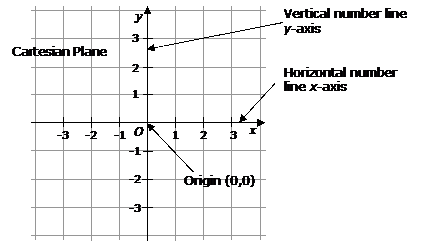Above you will see an example of the coordinate plane. The coordinate plane is a two dimensional surface on which you can plot points to create lines and curves.
The plane is constructed by two axes - the x-axis and the y-axis.
The x-axis is the horizontal (left/right) scale or number line with negative numbers two the left of zero and decreasing in value and positive numbers to the right of zero increasing in value.
The y-axis is the vertical (up/down) scale or number line with negative numbers two the below zero and decreasing in value and positive numbers to the above zero increasing in value.
Where the x and y axes cross is called the origin and is noted as (0,0).
The x and y axes also create four separate sections on the plane and are called quadrants. Quadrant I has both positive coordinates. The rest of the quadrants are numbered in counter clockwise order. (See image above)
You plot points using a value of x (horizontal) and a value for y (vertical). You need both values to plot a point and they are written as (x,y). They can be called coordinates or ordered pairs.
Features to Think About
- You can tell whether a point lies on the x or y axis by looking at the coordinates
- If the y coordinate is zero then the point lies on the x axis
- If the x coordinate is zero then the point lies on the y axis
- This should make sense because if there is no value for y, for example, the point will be neither above or below the x-axis.
- Because of what was mentioned in the previous bullet, not all points will be placed in one of the four quadrants. Some points will lie on either the x or y axis or on the origin iteself
Help Hints (Reasons for the Names)
- If you break the word COORDINATE into the prefix CO and the root ORDINATE, know that the prefix CO means 'together' and the root ordinate means 'place in orderly rows or regular fashion.'
- Think of ORIGIN is the beginning or a starting point
- Look at the word QUADRANT, 'quad' signifies 'four'
- To remember the order of your coordinates, think about why they are called ORDERED PAIRS. Notice that they are written in alphabetical order (x,y).
Uses for the Coordinate Plane
- Navigation
- Business and Statistics to track and understand trends
- Scientists and Economists to analyze relationships
Image From: http://www.learningwave.com/lwonline/algebra_section2/alg_coord.html


